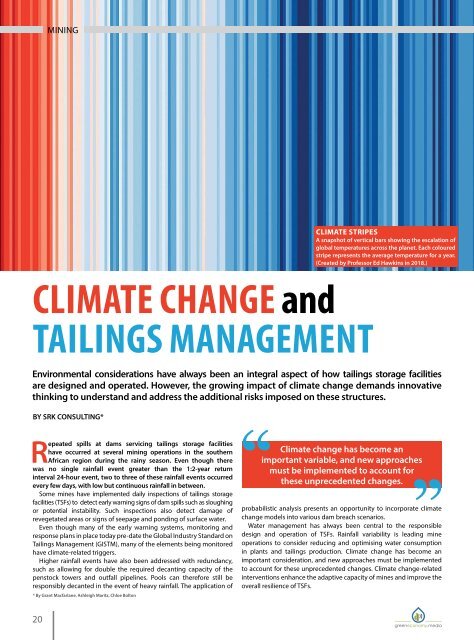Create successful ePaper yourself
Turn your PDF publications into a flip-book with our unique Google optimized e-Paper software.
MINING<br />
MINING<br />
GISTM REQUIREMENTS TO ADDRESS CLIMATE CHANGE<br />
Climate change mitigation has traditionally focused on the<br />
reduction of greenhouse gases. However, it is now accepted<br />
that a change in climate is inevitable and that mitigation will<br />
be insufficient. Now, the focus has shifted to include climate change<br />
adaptation: measures required to adjust to the changing climate to<br />
avoid significant risks.<br />
as monitoring and adaptation. The first two relate to planning<br />
and operation; monitoring and adaptation requirements include<br />
operation but extend for the life of the tailings facility through to<br />
closure and post-closure.<br />
The sixth assessment report released by the United Nations<br />
Intergovernmental Panel on Climate Change provides global models<br />
REQUIREMENT<br />
CLIMATE CHANGE<br />
RISK IDENTIFICATION<br />
MODELLING OF<br />
CLIMATE CHANGES<br />
MONITORING<br />
AND ADAPTATION<br />
TOPIC I – Resource rights and risks to public safety<br />
X<br />
TOPIC II – Site climate and breach analysis X X<br />
TOPIC II – Enhance resilience to climate change X X X<br />
TOPIC II – Include climate change uncertainties in design X X<br />
TOPIC II – Updates required for changing conditions X X<br />
CLIMATE CHANGE and<br />
TAILINGS MANAGEMENT<br />
CLIMATE STRIPES<br />
A snapshot of vertical bars showing the escalation of<br />
global temperatures across the planet. Each coloured<br />
stripe represents the average temperature for a year.<br />
(Created by Professor Ed Hawkins in 2018.)<br />
TOPIC III – Water management including CC impacts X X<br />
TOPIC V – Requirement 6.5: Change Management System<br />
Table 1: GISTM climate change requirements.<br />
These risks may include increased or decreased rainfall and increased<br />
temperatures with resulting increased prevalence in disasters such<br />
as floods, drought, heat waves and fires, competition for resources,<br />
changes in disease vectors, greater demands on infrastructure and<br />
associated social impacts. The risks and associated impacts of climate<br />
change are far-reaching and cross sector.<br />
The GISTM has included requirements for addressing climate<br />
change risks as they apply to tailings. These include several topics<br />
and are detailed in Table 1. The requirements include three main<br />
responses: identifying the risks, modelling the changes, as well<br />
* By Ashleigh Maritz, Philippa Burmeister<br />
that can inform the identification of risks. The GISTM, however,<br />
requires site-specific modelling to inform tailings design. It is further<br />
recommended that site-specific models be used to inform the water<br />
balance, assessment of impacts and enhancement of resilience.<br />
The GISTM does not provide a standard for site-specific modelling,<br />
but there are some best-practice guidelines that can inform the<br />
approach. Because these models have limitations, monitoring and<br />
ongoing adaptation are essential to ensure that risks are addressed. It<br />
is critical that monitored information is analysed to ensure trends are<br />
highlighted to inform required adaptation.<br />
X<br />
Environmental considerations have always been an integral aspect of how tailings storage facilities<br />
are designed and operated. However, the growing impact of climate change demands innovative<br />
thinking to understand and address the additional risks imposed on these structures.<br />
BY SRK CONSULTING*<br />
Repeated spills at dams servicing tailings storage facilities<br />
have occurred at several mining operations in the southern<br />
African region during the rainy season. Even though there<br />
was no single rainfall event greater than the 1:2-year return<br />
interval 24-hour event, two to three of these rainfall events occurred<br />
every few days, with low but continuous rainfall in between.<br />
Some mines have implemented daily inspections of tailings storage<br />
facilities (TSFs) to detect early warning signs of dam spills such as sloughing<br />
or potential instability. Such inspections also detect damage of<br />
revegetated areas or signs of seepage and ponding of surface water.<br />
Even though many of the early warning systems, monitoring and<br />
response plans in place today pre-date the Global Industry Standard on<br />
Tailings Management (GISTM), many of the elements being monitored<br />
have climate-related triggers.<br />
Higher rainfall events have also been addressed with redundancy,<br />
such as allowing for double the required decanting capacity of the<br />
penstock towers and outfall pipelines. Pools can therefore still be<br />
responsibly decanted in the event of heavy rainfall. The application of<br />
* By Grant Macfarlane, Ashleigh Maritz, Chloe Bolton<br />
Climate change has become an<br />
important variable, and new approaches<br />
must be implemented to account for<br />
these unprecedented changes.<br />
probabilistic analysis presents an opportunity to incorporate climate<br />
change models into various dam breach scenarios.<br />
Water management has always been central to the responsible<br />
design and operation of TSFs. Rainfall variability is leading mine<br />
operations to consider reducing and optimising water consumption<br />
in plants and tailings production. Climate change has become an<br />
important consideration, and new approaches must be implemented<br />
to account for these unprecedented changes. Climate change-related<br />
interventions enhance the adaptive capacity of mines and improve the<br />
overall resilience of TSFs.<br />
20<br />
21

















